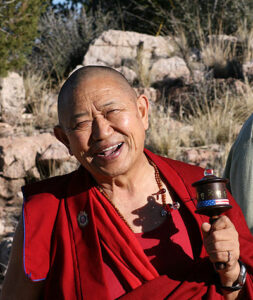Meditation Instructions by H.E. Garchen Rinpoche
Translated by Ina Bieler
I would like to respond to a question that many people ask. Since there is not enough time to answer each one individually, I would like to offer a single response that addresses a variety of questions that deal with the actual meaning of meditation. Students who have been practicing for many years still ask questions that make me wonder if they actually understand what meditation is. Therefore, I would like to offer one answer that can be applied to all questions that have to do with meditation.
What does it mean to meditate?
When you meditate you have to look at your mind. In the mind there is no delineation between self and other. There only appears to be a duality when it comes to physical matter, bodies. When you understand that there is just one single mind, you have understood meditation. When you understand that the minds of all beings are one, you have understood the nature of mind. For as long as you believe that minds are separate, no matter how much you meditate, you will not truly understand the nature of mind. These are words of personal experience.
The third eye between the eyebrows of the wisdom being (deity) is the sign that there is only one mind. What does “wisdom” mean? When you know how to meditate and see the nature of mind, then that mind is called “wisdom”. Wisdom beings know that we are not separate. This is why they are able to grant blessings.
We, on the other hand, have two eyes, which represent our dualistic grasping. We believe that our minds are separate, that samsara and nirvana are separate. Thus, our two eyes represent our belief in a self-other, subject-object duality. For example, we believe that two friends are two separate entities. However, the basis of their mind is one. If you understand this, you understand the correct view.
Even though we meditate, we still continue to firmly hold on to our ideas about existence as dualistic. This is why thoughts of attachment and aversion continue to arise. You need to understand that on the basis, there is no separation. Once you understand that there is no duality, you know that these thoughts of attachment and aversion arise from your false belief in a concrete, material world and your ideas about it, and therefore they are just confused delusions arising in your mind. The fundamental confusion is the firm belief in the duality of self and others. Confusion on the path is the dualistic mind that arises when ordinary emotions of attachment and aversion arise without examination or constraint. If you know how to meditate, then when afflictions arise, you know that in the mind there is no duality, and that the object of your anger or desire does not exist as an entity separate from yourself. Self and others are not separate. If you understand this, you understand the nature of mind. In brief, as long as you believe in the dualistic reality of self and other as separate entities, you do not really know how to meditate; you have not understood the actual nature of mind.
A sign that you have not really understood the nature of mind is that the emotions of attachment and aversion remain within your mind; you are unable to release them so completely that they leave no trace behind. For example, suppose you feel, “He doesn’t like me.” When you feel this way, you should develop the awareness that understands this feeling of resentment toward that person is just like feeling resentment toward an actor on TV. Instead, understand that he doesn’t really exist, and likewise you do not really exist. Then there is no one to be angry at, or no one to be attached to.
The understanding you gain through meditation must then be applied to your daily activities. If you grasp at duality in your day-to-day life, then ordinary, unrestrained confusion keeps your mind bound in fetters. If you understand non-duality, you might be bound for a little while at first, but you will be able to let it go so that the ice-block of your mind can melt. The difference between buddhas and sentient beings is like that between water and ice. Bodhicitta is like warmth, and when it arises in your mindstream, you will see the ultimate truth: non-duality; and with that, the ice-block will melt into the ocean.
Meditation
The purpose of meditation is to realize the nature of mind. You should begin your meditation by taking refuge and cultivating boundless love because when you meditate on the basis of love, your mind becomes all-pervasive, and only in such a boundless state will you realize the nature of mind as it truly is. Love is also your actual refuge, your actual protection. If you meditate without boundless love as a basis, if meditation is based on a mere intellectual understanding of emptiness, it will become merely conceptual.
Once you have given rise to boundless love, rest in a natural state while sustaining clear awareness. Clear awareness recognizes all thoughts and feelings that arise in your mind. At times, there will be a moment where no thoughts are present, a space in-between thoughts, and in this space you will experience the nondual nature of mind. As you continue your practice of sustaining awareness, this space of knowing your true nature will become longer, until it always remains.
In order to realize the true nature of mind—the blissful dharmakaya—you must realize that the way things appear, pleasant or unpleasant, is your own mind. Samsara is nothing else but the grasping at these thoughts and feelings. All happiness is a thought; all suffering is a thought. All thoughts arise from the belief in duality, the belief in a self existing separately from the other. In reality there is no delineation between self and other. When you meditate you gain a direct experience of this.
However, while many people are able to control their mind during meditation, only a few are able to bring this experience into their daily lives. If we do not merge meditation with daily conduct, we will miss the whole purpose of meditation, which is to diminish our clinging to thoughts and emotions. Once you have experienced your true nature—the blissful dharmakaya of boundless love—and merge it with your daily life, all external appearances and inner thoughts will appear as dream-like illusions.
Meditating on the Non-Duality of Self and Others – Amitabha Teaching called Revealing the Path to Liberation
“Look at the mind that is free of subject – object duality!” This is the point that we will contemplate. When you do not grasp at subject – object duality, when you see the nature of the mind and rest in this nature, all dualistic fixations will diminish naturally. How are we to meditate on this?
There is an easy way to contemplate this. For example, there are two people, two friends who love each other. Ordinarily, there is the thought that this is ‘me’ and this is ‘him’. But when you look further into the truth of that, you will see that what you call ‘me’ and what you call ‘him’ is really the body; we appear in the form of two bodies, but the bodies will be destroy in the end when we die. It will be burn away by fire or carried away by water. The body is not the ‘me’; the body is impermanent, it is compound and therefore we can’t find the ‘me’ in the body.
We may then think that the ‘me’ is the mind, so you should look inside your own mind and try to find the ‘I’, the ‘me’ in the mind. When you look inside your mind, there is no ‘I’ to be found there, but there is love that you have for your friend. Then, a very strange feeling will arise. You will think: when mind watches mind and looks at the love that is naturally there, although you cannot see it, there is a pervasive love. It is just like space but you can’t obtain it, you can’t find it. It has no form. When you look at the feeling of love that you have for that friend, your love and his love are the same.
Hence, we are actually non dual, we are not separate. You love that person and that person loves you. This love is the same. Our bodies will be destroyed but there is only one mind. Our minds are one, just like there is only one thing called water in the world. When we understand this, we will understand the non-duality of subject and object of self and others.
This is how we should first meditate: thinking of two people and realizing that we are actually one. Although our bodies appear as two, our mind is actually one. If we meditate in this way, we can understand our true nature.



